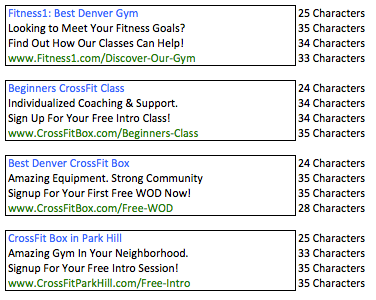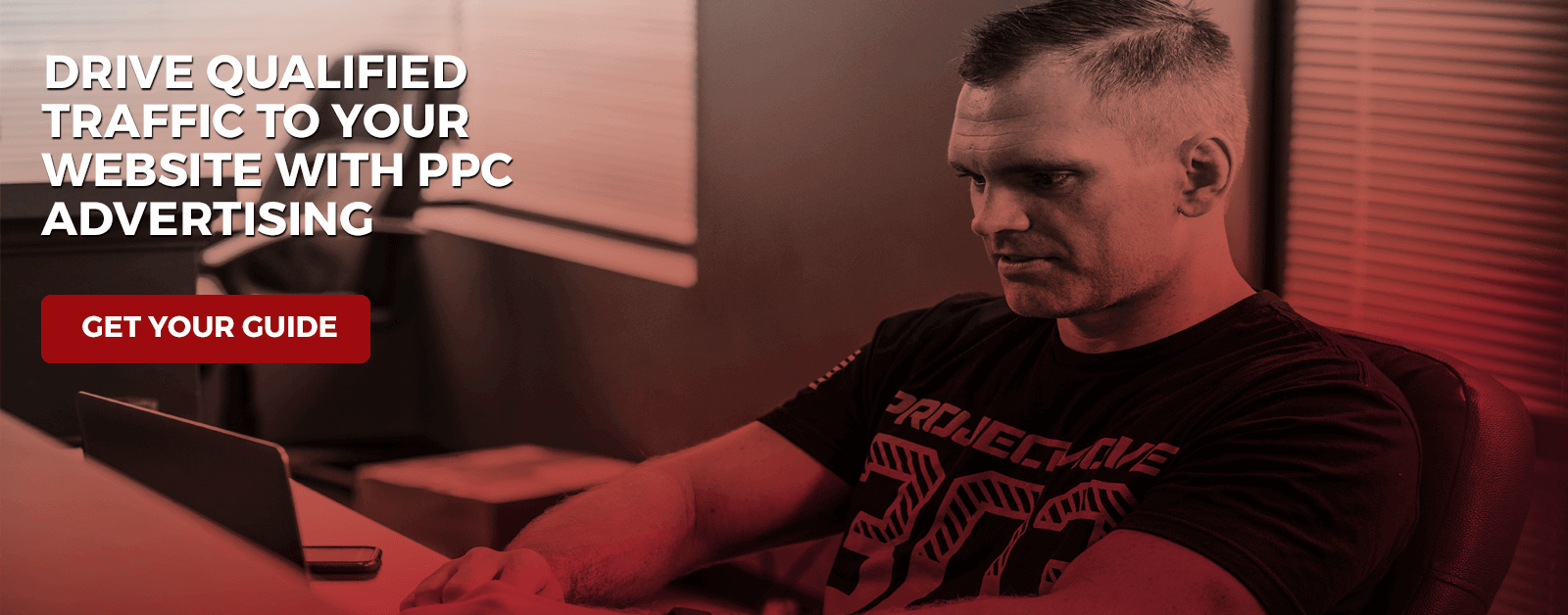Fitness Marketing Tips – AdWords Campaigns & Key PPC Metrics

Our SEM blog series is continuing its focus on PPC marketing for fitness businesses. We recently introduced the basics of PPC advertising in a blog provided details on how to develop your keyword list and tight-knit ad groups. Today’s blog will cover the remaining ingredients you need to finish setting up your account and launching it.
Enticing Ad Copy
In our previous post, we talked about the keyword component of ad groups, but there is another important component we didn’t cover, ads. Ads live at the ad group level of each campaign. Ideally, your ad groups should contain closely-knit keywords. When you have smaller ad groups (between three to 10 keywords), it’s much easier to write ad text that features these keywords. When users search on a term that is featured in the copy of an ad, Google will bold that term in your ad. This helps your ads stand out, and makes them appear more relevant to searchers.
Our previous blog on breaking into PPC advertising with AdWords Express provides a basic overview on the structure of PPC ads. To recap, every ad contains a title, two description lines and a URL. There are character limits for each of these components (see image below).

Your title should feature a keyword, and if there’s room, branding as well. Your first description line should feature a different keyword and speak to your target market. This can be done by asking a question or providing a very brief overview of what your fitness business offers. The second line should contain a call-to-action that both entices searchers to click on your ad and guides them towards what they should do once on your site. The website URL is pretty self-explanatory, but offers an additional way to get keywords incorporated into your ad text. After you type in your URL, you can add a keyword-rich or offer-focused extension (www.yoursite.com/Keyword-Rich-Extension). This extension is not clickable and does not have to be a live URL. Be sure to separate each word in your extension with a hyphen, as it will make the URL easier for searchers to read. Below you will find examples of different types of ad text for local fitness businesses.

There’s one additional component of ads that aren’t visible in the search results, and that’s the destination URL. For every ad, you have to assign a specific URL on your site that you want visitors to arrive on once they’ve clicked on the ad. Remember, there are two different URLs for each ad: the display URL (the vanity URL that the advertiser makes up which is displayed within the ad in the search results) and the destination URL (not visible in the ads, but where visitors will go once they click on your ad).
When launching your campaigns, I recommend having four ads in each ad group. Develop two very different ads, then create a slightly different version of each one (change the title, change the keyword, adjust the call-to-action). This is referred to as A/B testing and will allow you to determine which small changes lead to bigger click volumes. It’s best to let these ads run for at least a month before determining the winner and starting a new test.
Campaign Structure
Campaigns are where everything within your PPC program, keywords, ads and ad groups, lives. You want to get fairly specific when organizing ad groups, but can be a bit more general with your campaign organization. You can organize campaigns in a number of different ways, such as:
• Class Type: If you’re a mixed martial arts gym, you might want to have campaigns organized by the different types of MMA programs you offer, like Campaign 1: BJJ, Campaign 2: Judo, Campaign 3: Self Defense, etc. If you’re a CrossFit gym, you could organize campaigns by the different types of classes you offer, like Campaign 1: CrossFit General, Campaign 2: FIT Classes, Campaign 3: Oly Weightlifting, etc.
• Demographics: Another great way to organize campaigns is by your target market. If you’re a martial arts school, you’re probably targeting both adults and children, but you wouldn’t want to use the exact same messaging to speak to these two different groups. When targeting different groups, you could organize your campaigns like: Campaign 1: Taekwondo Adults, Campaign 2: Taekwondo Children, Campaign 3: Taekwondo Teens, Campaign 4: Karate Adults, Campaign 5: Karate Children, Campaign 6: Karate Teens, etc.
• Neighborhoods: If your fitness business is convenient for several different neighborhoods, it might make sense to develop separate campaigns targeted to each of these neighborhoods. These campaigns can contain the same ad groups and keyword lists but would have ads that speak directly to residents of that specific neighborhood.
• Location: If you own a multi-location fitness business, setting up campaigns by location is a great option. This will allow you to set zip code targeting for each separate location, as well as feature location specific text in the ads.
Remember, campaigns are where you’ll set your daily budgets, so choose wisely on how you want them to be organized. If you really are interested in getting new members from a certain type of class, then you should probably organize your campaigns by class and dedicate the highest budget to the class campaign of your choice. If you’re only interested in getting new members who are between a certain age, you should probably organize your campaigns by age groups.
Once you’ve decided how to organize your campaigns, you’ll need to make the proper adjustments to each campaigns’ settings to ensure you’re reaching your ideal target market. When setting up campaigns, be sure to adjust the following targeting options:
• Campaign Type: This is extremely important for first time advertisers. Be sure to select “Search Network Only.” If you do not select this, your ads will show up in Google’s Display Network. The Display Network has its benefits, but it is not something I recommend venturing into if you’re a first-time PPC advertiser.
• Devices: Google will automatically show your ads to all types of devices (desktop, mobile phones and tablets), which is great if your website displays well on mobile devices. If your site looks terrible on a cell phone, we highly recommend that you decrease your mobile bids.
• Locations: Unless you own a nationwide chain of fitness businesses, you probably don’t want your ads to show up to people searching in Vermont and Arizona. For local businesses, location targeting is extremely important. The best targeting options for local businesses are zip codes and city names. When entering zip codes and city names, you have two options: to add that location to your targeting or to exclude it. We recommend setting up location targeting, as well as location exclusions, to ensure your ads appear to the most relevant audience possible.
• Budget: Your budget is the amount you’re comfortable spending everyday on each campaign. It’s important to note that your ads might spend up to 20% more than what your daily budget is set to, so be sure to pick a budget that allows your ads to run enough to meet goals. Also, you need to pick a budget that’s high enough to let your ads perform. If you have 70 keywords in a campaign, and only have a daily budget of $3.00, you will not get a good gauge on which keywords can spend.
The options listed above are the most important options within the settings tab, however, there are several other options you can adjust. Other options within this tab include how quickly your ads will spend, if you want to setup start and end dates for a campaign, how you want to define your bid strategy and much more. Play around with these different targeting methods to determine what works best for your campaigns.
Important Campaign Metrics
You have all of the information you need to create campaigns in AdWords and to set them live, but how in the world do you gauge their success? There are a couple key metrics that you need to know about in order to understand whether or not your campaigns are performing well.
• Clicks: This one is pretty straightforward. Every time a user clicks on your ad, it’s counted as a click. Typically, extremely relevant, targeted ads tend to receive more clicks. Also, the more you spend, the higher your click volume will be.
• Impressions: Every time a user performs a search and your ad appears in the results, it’s counted as an impression. Impressions tell you how often your ad is being seen. If you have a ton of impressions and not many clicks, you probably need to change the keyword’s match type, or adjust your ad copy.
• Clickthrough Rate (CTR): This measurement tells you how often people click on your ad when it’s displayed, and can help you determine how effective an ad/keyword is. The CTR is calculated by the number of clicks your ad/keyword receives divided by the number of impressions. 2% is widely accepted as a strong CTR. Typically, branded keywords will have a much higher CTR than more general terms.
• Cost: This tells you how much money each campaign has spent during a selected period of time.
• Average Cost-Per-Click (Avg. CPC): This is the average amount that you’re spending on a click in a specific campaign. This amount is calculated by dividing the total spend for a campaign by the total number of clicks. You can control the maximum amount you want to spend on clicks for each keyword by setting the keyword’s max. CPC.
• Average Position (Avg. Pos.): This metric tells you where your ad ranks in comparison to other advertisers. Typically, the higher your ad is ranked, the better performance you will see.
• Quality Score (Qual. Score): Each keyword receives a quality score, which is an estimate of the quality of your ads and landing pages that are triggered by a keyword. The score is on a scale of 1-10, 1 being the lowest and 10 being the best. It’s difficult to determine exactly how Google calculates the quality score, but it does have an impact on your ads’ positioning.
Now that you know the essential components of a PPC advertising campaign, as well as the main metrics to determine if your campaign is working, you’re ready to set your campaigns live! In our next SEM blog series post, we’ll cover more advanced campaign features including different types of ad extensions and how to setup and track conversions from your ads.
Hungry for new ways to improve the marketing efforts of your fitness business? Download our free, comprehensive Guide to PPC Marketing. This eBook contains step-by-step directions to create campaigns and get them up and running in no time.

I’m Coach Kelli, a devoted CrossFit gym owner with 15 years of experience managing my facility, along with owning yoga studios and wellness centers. Beyond the fitness world, I have a passion for cooking, cherish moments with my children and family, and find joy in spending time outside. Having experienced the highs and lows, I’m dedicated to leveraging my expertise to help you grow and succeed on your fitness journey.

I’m Coach Kelli, a devoted CrossFit gym owner with 15 years of experience managing my facility, along with owning yoga studios and wellness centers. Beyond the fitness world, I have a passion for cooking, cherish moments with my children and family, and find joy in spending time outside. Having experienced the highs and lows, I’m dedicated to leveraging my expertise to help you grow and succeed on your fitness journey.




